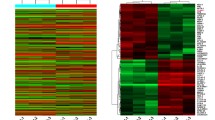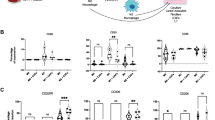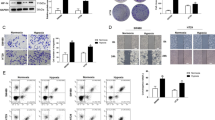Abstract
Purpose
Macrophages (MΦs) play a dual role in the promotion and suppression of lung adenocarcinoma (LUAD), the function of which is influenced by the metabolic status. The role of protein tyrosine phosphatase receptor type F (PTPRF) in cancer has not been elucidated, and its role in MΦs remains to be seen.
Methods
The Seahorse XFe 96 Cell Flow Analyzer detected glucose metabolism in tumor cells and macrophages. The expressions of FSCN1, M-CSF, IL4, PTPRF and IGF1 in macrophages were detected by Western blotting and qRT-PCR. Binding of FSCN1 and IGF1R was detected by co-immunoprecipitation. The tumor status in animals was observed using the IVIS Lumina III imaging system.
Results
We found that Fascin Actin-Bundling Protein 1 (FSCN1) activates the PI3K-AKT and JAK-STAT signaling pathways in LUAD cells via binding to IGF-1R, thereby promoting the secretion of cytokines such as IL4 and M-CSF. IL4 and M-CSF promote the expression of PTPRF in MΦs, leading to M2 polarization of MΦs by increasing glucose intake and lactate production. In return, M2-type MΦs act on LUAD cells by secreting cytokines such as IGF-1, CCL2, and IL10, which ultimately promote tumor progression. In vivo experiments proved that the knockdown of FSCN1 in A549 cells and PTPRF in MΦs greatly reduced LUAD proliferative and metastatic capacity, which was consistent with the in vitro findings.
Conclusions
This study investigated the reprogramming effects of FSCN1 and PTPRF on inflammatory cytokines in the LUAD microenvironment, revealing potential mechanisms by which FSCN1 and PTPRF promote tumor progression and providing a new experimental basis for LUAD treatment.






Similar content being viewed by others
Data availability
The inquiry of original data can be directed to the corresponding authors for rational reasons.
References
H. Sung, J. Ferlay, R.L. Siegel, M. Laversanne, I. Soerjomataram, A. Jemal et al., Global cancer statistics 2020: GLOBOCAN estimates of incidence and mortality worldwide for 36 cancers in 185 countries. CA Cancer J. Clin. 71, 209–249 (2021)
R.S. Herbst, D. Morgensztern, C. Boshoff, The biology and management of non-small cell lung cancer. Nature 553, 446–454 (2018)
I. Hwang, J.W. Kim, K. Ylaya, E.J. Chung, H. Kitano, C. Perry et al., Tumor-associated macrophage, angiogenesis and lymphangiogenesis markers predict prognosis of non-small cell lung cancer patients. J. Transl. Med. 18, 443 (2020)
X. Dai, L. Lu, S. Deng, J. Meng, C. Wan, J. Huang et al., USP7 targeting modulates anti-tumor immune response by reprogramming Tumor-associated Macrophages in Lung Cancer. Theranostics 10, 9332–9347 (2020)
Y. Pan, Y. Yu, X. Wang, T. Zhang, Tumor-Associated Macrophages in Tumor Immunity. Front. Immunol. 11, 583084 (2020)
S.L. Wood, M. Pernemalm, P.A. Crosbie, A.D. Whetton, The role of the tumor-microenvironment in lung cancer-metastasis and its relationship to potential therapeutic targets. Cancer Treat. Rev. 40, 558–566 (2014)
I. Rhee, Diverse macrophages polarization in tumor microenvironment. Arch. Pharm. Res. 39, 1588–1596 (2016)
M. Najafi, N. Hashemi Goradel, B. Farhood, E. Salehi, M.S. Nashtaei, N. Khanlarkhani et al., Macrophage polarity in cancer: A review. J. Cell. Biochem. 120, 2756–2765 (2019)
S. Wang, R. Liu, Q. Yu, L. Dong, Y. Bi, G. Liu, Metabolic reprogramming of macrophages during infections and cancer. Cancer Lett. 452, 14–22 (2019)
Y. Chen, T. Tian, Z.Y. Li, C.Y. Wang, R. Deng, W.Y. Deng et al., FSCN1 is an effective marker of poor prognosis and a potential therapeutic target in human tongue squamous cell carcinoma. Cell Death Dis. 10, 356 (2019)
T. Chiyomaru, H. Enokida, S. Tatarano, K. Kawahara, Y. Uchida, K. Nishiyama et al., miR-145 and miR-133a function as tumour suppressors and directly regulate FSCN1 expression in bladder cancer. Br. J. Cancer 102, 883–891 (2010)
I. Gupta, S. Vranic, H. Al-Thawadi, A.E. Al Moustafa, Fascin in gynecological cancers: An update of the literature. Cancers (Basel). 13, 5760 (2021)
M. Kano, N. Seki, N. Kikkawa, L. Fujimura, I. Hoshino, Y. Akutsu et al., miR-145, miR-133a and miR-133b: Tumor-suppressive miRNAs target FSCN1 in esophageal squamous cell carcinoma. Int. J. Cancer 127, 2804–2814 (2010)
J. Liang, Z. Liu, X. Wei, L. Zhou, Y. Tang, C. Zhou et al., Expression of FSCN1 and FOXM1 are associated with poor prognosis of adrenocortical carcinoma patients. BMC Cancer 19, 1165 (2019)
S.J. Kim, D.C. Kim, M.C. Kim, G.J. Jung, K.H. Kim, J.S. Jang et al., Fascin expression is related to poor survival in gastric cancer. Pathol. Int. 62, 777–784 (2012)
C.-Q. Wang, C.-H. Tang, Y. Wang, L. Jin, Q. Wang, X. Li et al., FSCN1 gene polymorphisms: biomarkers for the development and progression of breast cancer. Sci. Rep. 7, 15887 (2017)
M. Zhang, Z. Zhao, X. Duan, P. Chen, Z. Peng, H. Qiu, FSCN1 predicts survival and is regulated by a PI3K-dependent mechanism in renal cell carcinoma. J. Cell Physiol. 233, 4748–4758 (2018)
D. Soulieres, F.R. Hirsch, F.A. Shepherd, W. Bordogna, P. Delmar, D.S. Shames et al., PTPRF expression as a potential prognostic/predictive marker for treatment with erlotinib in non-small-cell lung cancer. J. Thorac. Oncol. 10, 1364–1369 (2015)
W.W. Du, L. Fang, M. Li, X. Yang, Y. Liang, C. Peng et al., MicroRNA miR-24 enhances tumor invasion and metastasis by targeting PTPN9 and PTPRF to promote EGF signaling. J. Cell Sci. 126, 1440–1453 (2013)
O.R. Colegio, N.Q. Chu, A.L. Szabo, T. Chu, A.M. Rhebergen, V. Jairam et al., Functional polarization of tumour-associated macrophages by tumour-derived lactic acid. Nature 513, 559–563 (2014)
R. Dziadziuszko, D.R. Camidge, F.R. Hirsch, The insulin-like growth factor pathway in lung cancer. J. Thorac. Oncol. 3, 815–818 (2008)
J.M. Pitt, A. Marabelle, A. Eggermont, J.C. Soria, G. Kroemer, L. Zitvogel, Targeting the tumor microenvironment: removing obstruction to anticancer immune responses and immunotherapy. Ann. Oncol. 27, 1482–1492 (2016)
P.J. Murray, Macrophage Polarization. Annu. Rev. Physiol. 79, 541–566 (2017)
I. Vitale, G. Manic, L.M. Coussens, G. Kroemer, L. Galluzzi, Macrophages and Metabolism in the Tumor Microenvironment. Cell Metab. 30, 36–50 (2019)
M. Wenes, M. Shang, M. Di Matteo, J. Goveia, R. Martin-Perez, J. Serneels et al., Macrophage Metabolism Controls Tumor Blood Vessel Morphogenesis and Metastasis. Cell Metab. 24, 701–715 (2016)
D.G. DeNardo, B. Ruffell, Macrophages as regulators of tumour immunity and immunotherapy. Nat. Rev. Immunol. 19, 369–382 (2019)
A. Schmall, H.M. Al-Tamari, S. Herold, M. Kampschulte, A. Weigert, A. Wietelmann et al., Macrophage and cancer cell cross-talk via CCR2 and CX3CR1 is a fundamental mechanism driving lung cancer. Am. J. Respir. Crit. Care Med. 191, 437–447 (2015)
S. Saha, I.N. Shalova, S.K. Biswas, Metabolic regulation of macrophage phenotype and function. Immunol. Rev. 280, 102–111 (2017)
L. Zhu, Q. Zhao, T. Yang, W. Ding, Y. Zhao, Cellular metabolism and macrophage functional polarization. Int. Rev. Immunol. 34, 82–100 (2015)
K. Mehla, P.K. Singh, Metabolic regulation of macrophage polarization in cancer. Trends Cancer 5, 822–834 (2019)
G.M. Tannahill, A.M. Curtis, J. Adamik, E.M. Palsson-McDermott, A.F. McGettrick, G. Goel et al., Succinate is an inflammatory signal that induces IL-1beta through HIF-1alpha. Nature 496, 238–242 (2013)
Y. Wang, A. Shan, Z. Zhou, W. Li, L. Xie, B. Du et al., LncRNA TCONS_00004099-derived microRNA regulates oncogenesis through PTPRF in gliomas. Ann. Transl. Med. 9, 1023 (2021)
R. Bera, C.Y. Chiou, M.C. Yu, J.M. Peng, C.R. He, C.Y. Hsu et al., Functional genomics identified a novel protein tyrosine phosphatase receptor type F-mediated growth inhibition in hepatocarcinogenesis. Hepatology 59, 2238–2250 (2014)
T.E. Whitmore, A. Peterson, T. Holzman, A. Eastham, L. Amon, M. McIntosh et al., Integrative analysis of N-linked human glycoproteomic data sets reveals PTPRF ectodomain as a novel plasma biomarker candidate for prostate cancer. J. Proteome Res. 11, 2653–2665 (2012)
T. Gan, A.T. Stevens, X. Xiong, Y.A. Wen, T.N. Farmer, A.T. Li et al., Inhibition of protein tyrosine phosphatase receptor type F suppresses Wnt signaling in colorectal cancer. Oncogene 39, 6789–6801 (2020)
M. Scrima, C. De Marco, F. De Vita, F. Fabiani, R. Franco, G. Pirozzi et al., The nonreceptor-type tyrosine phosphatase PTPN13 is a tumor suppressor gene in non-small cell lung cancer. Am. J. Pathol. 180, 1202–1214 (2012)
P. Ji, Y. Gong, M.-L. Jin, H.-L. Wu, L.-W. Guo, Y.-C. Pei et al., In vivo multidimensional CRISPR screens identify as an immunotherapy target in triple-negative breast cancer. Sci Adv 8, eab18247 (2022)
R. Kang, M. Gamdzyk, Y. Luo, H. Tang, L. Huang, C. Lenahan et al., Three days delayed recanalization improved neurological function in pMCAO Rats by increasing M2 microglia-possible involvement of the IL-4R/STAT6/PPARγ pathway. Transl. Stroke Res. (2022)
C.N. Kosti, P.C. Vaitsi, A.G. Pappas, M.P. Iliopoulou, K.K. Psarra, S.F. Magkouta et al., CSF1/CSF1R signaling mediates malignant pleural effusion formation. JCI Insight. 7(6), e155300 (2022)
Funding
This research was funded by the National Natural Science Foundation of China (No. 82203645), the Yangfan plan program of Shanghai (No. 22YF107300), Special Foundation for Supporting Biomedical Technology of Shanghai, China (No. 22S11900300), and the Research Foundation of Shanghai Municipal Health Commission (No. 20204Y0228).
Author information
Authors and Affiliations
Contributions
(I) Conception and design were contributed by Cheng Zhan, Wei Jiang, and Qun Wang;
(II) Administrative support was contributed by Di Ge, Lijie Tan, and Cheng Zhan;
(III) Experiments were conducted by and Yiwei Huang, Yanjun Yi, and Guangyao Shan;
(IV) Collection and assembly of data were contributed by Guangyao Shan, and Guoshu Bi;
(V) Data analysis and interpretation were contributed by Guangyao Shan, Jiaqi Liang, Guoshu Bi, Zhengyang Hu, Zhencong Chen, and Junjie Xi;
(VI) Manuscript writing was contributed by all authors;
(VII) Final approval of manuscript was contributed by all authors.
Corresponding authors
Ethics declarations
Competing interests
The authors declare no competing interests.
Ethics approval and consent to participate
The authors are accountable for all aspects of the work in ensuring that questions related to the accuracy or integrity of any part of the work are appropriately investigated and resolved. The study was conducted in accordance with the Declaration of Helsinki and was approved by the ethical committees of Zhongshan Hospital (approval number: B2021-136).
Conflict of interest
The authors declare no competing interest in this work.
Additional information
Publisher's note
Springer Nature remains neutral with regard to jurisdictional claims in published maps and institutional affiliations.
Supplementary Information
Below is the link to the electronic supplementary material.

13402_2022_726_MOESM1_ESM.jpg
Supplementary figure 1 (a) Western blot showed the expression changing of Stat1, Stat5, Stat6, p-Stat1, p-Stat5, p-Stat6 after knocking down the FSCN1. (b,c) ELISA showed changes in the content of M-CSF and IL4 secreted by A549 after knockdown of FSCN1. (d) Flow cytometry detected the effect of the M-CSF and IL4 on macrophage polarization when they added to the culture supernatant of FSCN1-knockdown A549 cells. (JPG 1081 KB)

13402_2022_726_MOESM2_ESM.jpg
Supplementary figure 2 (a) Heatmap of the top 50 DEGs of macrophages (derived from THP-1 cells) cocultured with FCSN1-knockdown or control A549 cells. (b) The volcano plot of the DEGs of macrophages (derived from THP-1 cells) cocultured with FCSN1-knockdown or control A549 cells. (c) The expression level of PTPRF in tumor tissue and adjacent normal tissue of LUAD. (d) Kaplan-Meier survival analysis between the LUAD patients from TCGA with different PTPRF expression levels. (e) The Spearman correlation analysis between FSCN1 expression level and macrophage infiltration level. (f) The Spearman correlation analysis between FSCN1 expression level and FSCN1 expression level. TCGA, The Cancer Genome Atlas. *, p < 0.05. (JPG 2131 KB)

13402_2022_726_MOESM3_ESM.jpg
Supplementary figure 3 (a) Statistical analysis of flow cytometry results of Figure 3k. (b) Western blot showed the effect of overexpression of PTPRF on the expression of GLUT1 on the membrane protein of M2-type macrophages. (c) Western blot showed the effect of overexpression of PTPRF on the polarization of MΦ in the absence of glucose. (JPG 810 KB)

13402_2022_726_MOESM4_ESM.jpg
Supplementary figure 4 Effect of PI3K-AKT signaling pathway on A549 glycolysis detected by Seahorse XFe 96 energy analyzer. (JPG 752 KB)

Rights and permissions
Springer Nature or its licensor holds exclusive rights to this article under a publishing agreement with the author(s) or other rightsholder(s); author self-archiving of the accepted manuscript version of this article is solely governed by the terms of such publishing agreement and applicable law.
About this article
Cite this article
Huang, Y., Shan, G., Yi, Y. et al. FSCN1 induced PTPRF-dependent tumor microenvironment inflammatory reprogramming promotes lung adenocarcinoma progression via regulating macrophagic glycolysis. Cell Oncol. 45, 1383–1399 (2022). https://doi.org/10.1007/s13402-022-00726-0
Accepted:
Published:
Issue Date:
DOI: https://doi.org/10.1007/s13402-022-00726-0




